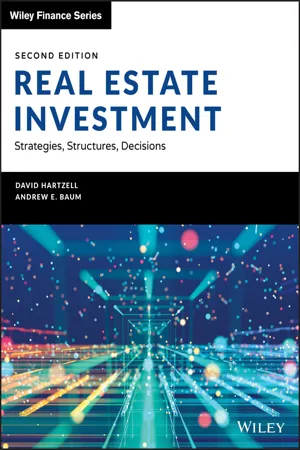
Real Estate Investment and Finance
Strategies, Structures, Decisions
- English
- ePUB (mobile friendly)
- Available on iOS & Android
About this book
The fully revised and updated version of the leading textbook on real estate investment, emphasising real estate cycles and the availability and flow of global capital
Real Estate Investment remains the most influential textbook on the subject, used in top-tier colleges and universities worldwide. Its unique, practical perspective on international real estate investment focusses on real-world techniques which measure, benchmark, forecast and manage property investments as an asset class. The text examines global property markets and real estate cycles, outlines market fundamentals and explains asset pricing and portfolio theory in the context of real estate.
In the years since the text's first publication, conditions in global real estate markets have changed considerably following the financial crisis of 2008-2009. Real estate asset prices have increased past pre-crisis levels, signalling a general market recovery. Previously scarce debt and equity capital is now abundant, while many institutions once averse to acquiring property are re-entering the markets. The latest edition – extensively revised and updated to address current market trends and practices as well as reflect feedback from instructors and students – features new content on real estate development, improved practical examples, expanded case studies and more. This seminal textbook:
- Emphasises practical solutions to real investing problems rather than complex theory
- Offers substantial new and revised content throughout the text
- Covers topics such as valuation, leasing, mortgages, real estate funds, underwriting and private and public equity real estate
- Features up-to-date sections on performance measurement, real estate debt markets and building and managing real estate portfolios
- Includes access to a re-designed companion website containing numerous problems and solutions, presentation slides and additional instructor and student resources
Written by internationally-recognised experts in capital management and institutional property investing strategies, Real Estate Investment, Second Edition: Strategies, Structures, Decisions is an indispensable textbook for instructors and students of real estate fund management, investment management and investment banking, as well as a valuable reference text for analysts, researchers, investment managers, investment bankers and asset managers.
Frequently asked questions
- Essential is ideal for learners and professionals who enjoy exploring a wide range of subjects. Access the Essential Library with 800,000+ trusted titles and best-sellers across business, personal growth, and the humanities. Includes unlimited reading time and Standard Read Aloud voice.
- Complete: Perfect for advanced learners and researchers needing full, unrestricted access. Unlock 1.4M+ books across hundreds of subjects, including academic and specialized titles. The Complete Plan also includes advanced features like Premium Read Aloud and Research Assistant.
Please note we cannot support devices running on iOS 13 and Android 7 or earlier. Learn more about using the app.
Information
PART One
Real Estate as an Investment: An Introduction
CHAPTER 1
Real Estate – The Global Asset
1.1 THE GLOBAL PROPERTY INVESTMENT UNIVERSE
Table of contents
- Cover
- Table of Contents
- Title Page
- Copyright
- Dedication
- Acknowledgements
- About the Authors
- Preface
- PART One: Real Estate as an Investment: An Introduction
- PART Two: Making Investment Decisions at the Property Level
- PART Three: Real Estate Investment Structures
- PART Four: Creating a Property Investment Portfolio
- REFERENCES
- Glossary
- Index
- End User License Agreement